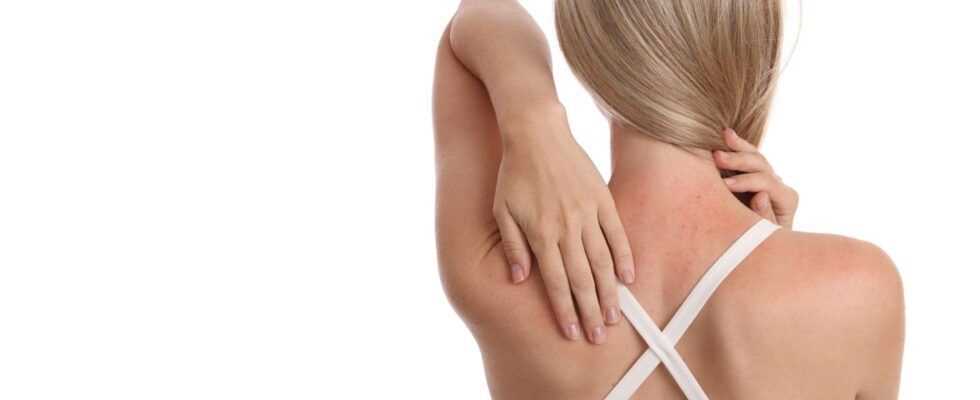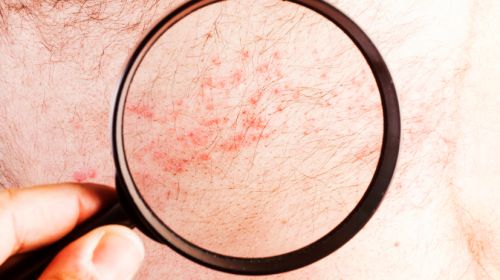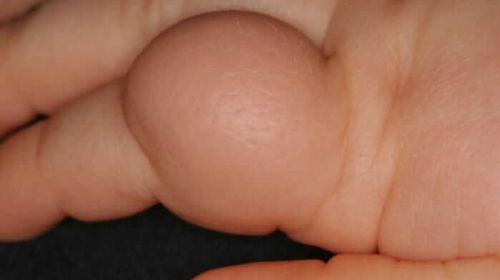Hives or urticaria are among the most common skin diseases. Sudden, severely itchy wheals or pustules, which also look bad, are typical. The causes often remain unclear, but hives are not contagious.
- Hives is a skin rash that is characterized by itchy wheals and pustules.
- © Albina Gavrilovic via Getty Images
If itchy wheals or pustules suddenly appear on isolated parts of the body or on the whole body, it is probably a hives or nettle rash, medical urticaria.
The wheals vary in size and are similar to those that appear when you touch a nettle. The medical term urticaria is derived from this; it goes back to "urtica", the Latin word for nettle.
The rash is one of the most common skin diseases and is a reaction of the skin to a multitude of possible triggers. These can be, for example, drugs, allergens, pseudoallergens and environmental influences such as heat or cold. It is estimated that one in four people will have hives at least once in their life.
There are two main groups of hives:
- the spontaneous urticaria and
- physical urticaria.
There are also special forms such as cholinergic urticaria or contact urticaria.
Spontaneous urticaria is the most common form of hives
A distinction is made here between an acute type, in which the symptoms disappear after days or weeks, sometimes even after hours, and a chronic type.
Chronic hives are when the symptoms persist for more than six weeks or keep recurring.
Physical urticaria is characterized by the fact that the typical symptoms are triggered by external stimuli that act on the skin. This can be, for example, pressure, vigorous rubbing, heat, cold or light. Correspondingly, the sub-forms of physical urticaria are named according to the triggering factors, for example heat, pressure or cold urticaria.
In general, women and men of all ages can develop hives. However, the most common skin disease occurs between the ages of 30 and 50 years. Women are particularly often affected by the chronic form of spontaneous urticaria, while physical urticaria is more common in men.
Cholinergic urticaria, also known as cholinergic and triggered by increased body temperature, as well as idiopathic (unexplained) urticaria often occur among young adults: According to Professor Torsten Zuberbier from the Clinic for Dermatology, Venereology and Allergology at Charité Berlin, im Around one in five people in their early to mid-twenties is affected.
White pustules and wheals are typical symptoms
Hives and urticaria are characterized by wheals and pustules of various sizes from just a few millimeters to the size of the palm of the hand. They appear within minutes and can cover areas of skin of different sizes, sometimes the whole body. The skin around the wheals is usually red and hot, while the wheals or pustules themselves are often whitish. The raised skin can also be red. It is typical of hives that the rash is very itchy.
In addition to the wheals, angioedema often occurs in half of the cases added. This is to be understood as suddenly occurring swellings which, in contrast to urticaria wheals, do not or hardly itch. They occur preferentially on the face, especially on the eyelids and lips. The genitals and mouth can also be affected– and pharynx.
More symptoms of hives
These include tiredness, headache and joint pain, respiratory and gastrointestinal complaints. Chronic hives can also trigger psychological symptoms due to the severe itching and the resulting lack of sleep.
Causes of Urticaria
The causes of hives or urticaria can be many. What all triggers have in common is the reaction they provoke in the skin: the mast cells in the skin are irritated.
Mast cells serve the body's own defense. They store messenger substances such as histamine, which are released when the mast cells are stimulated. Under the influence of histamine and other messenger substances involved in inflammation, the blood vessels expand, which causes reddening of the affected skin area. They also become temporarily more permeable. This causes water to escape, which is pressed into the upper layer of the skin – the typical wheals or pustules develop. Histamine also triggers itching by irritating the nerve cells.
Angioedema develops in principle in the same way. The difference is that this is water retention in the deeper layers of the skin.
The stimulation of the mast cells can be triggered by allergic reactions, for example to food or insect bites. Skin contact with an allergen can also trigger the itchy rash.
Non-allergic triggers of hives
Infections: for example sinuses– or Tonsillitis, hepatitis B or gastrointestinal infections. They are behind 40 percent of acute hives with an identified cause.
Intolerances: for example, to drugs, such as the active ingredient acetylsalicylic acid, are responsible for around ten percent of cases. It is not uncommon for physical influences that act on the skin from the outside, such as pressure, friction, heat, cold or sun rays (physical urticaria).
physical exertion and mental stress: They can lead to cholinergic urticaria. It is the increase in body temperature that triggers the rash.
In most cases, however, the trigger in acute forms of spontaneous urticaria remains unclear. They are summarized under the term idiopathic urticaria.
In chronic urticaria, the main triggers are:
- Intolerance reactions
- chronic infections, which often cause no other symptoms apart from urticaria
- Intolerance of the body's own substances (auto-reactivity)
Hives are easy to spot
The diagnosis of hives is easy for a doctor to make because of their external appearance. However, it is difficult to identify the triggers. This is especially important if it is a chronic form of hives that torments the person permanently or repeatedly in bouts.
Here, the anamnesis, i.e. the detailed questioning and collection of the medical history by the doctor, plays a decisive role. If physical urticaria is suspected, the doctor will investigate this with various tests. This could be, for example, stroking the skin with a hard object to see if it is causing the wheals or pustules.
The doctor can use laboratory tests to search for chronic infections, intolerances or auto-reactivity as a trigger. In order to rule out infections in the ear, nose and throat area, an examination by a specialist in ear, nose and throat medicine, who may also use imaging procedures, can be useful.
The autological serum test is especially useful for determining auto-reactivity for use. Serum is obtained from the patient's freshly drawn blood and injected into the skin. The size of the resulting wheals or pustules provides crucial diagnostic information.
Diagnosing hives due to food intolerance
If there is a suspicion of a food intolerance, a diet lasting several weeks with "pseudoallergenic food" Bring information. This means leaving out certain foods that contain pseudoallergens. These are substances that do not actually trigger an allergic reaction, but to which the body responds with intolerance reactions – such as hives, for example.
Pseudoallergens include:
- Colorings and preservatives
- Gelling and thickening agents
- Emulsifiers
- Flavor enhancers
- Sweeteners or sweeteners or raising agents
If the urticaria improves after a few weeks, the cross-check can be carried out with a two to four-day provocation diet be carried out with pseudo-allergenic food. If the symptoms worsen, the hives are very likely to be an intolerance reaction.
The person affected can help to track down the trigger factors of chronic hives by keeping a hives diary. Symptoms such as wheals, pustules, pruritus and angioedema, as well as other general symptoms, including fatigue, headache and joint pain, are noted in it. The intensity of the complaints is also recorded. For this purpose, accompanying circumstances and activities should be documented. This makes it possible to determine whether certain foods, medication, stress or sports activities are related to urticaria.
Therapy of hives depending on the cause
The therapy of hives consists primarily in eliminating the causes. In the case of acute spontaneous urticaria, the symptoms of which disappear on their own within a short period of time, extensive research into the cause is usually not worthwhile.
The main focus of therapy is on suppressing symptoms. So-called antihistamines are used for this. These are drugs that block the action of the messenger substance histamine. This can bring the itching under control and reduce the wheals or pustules.
Antihistamines are also used to treat chronic hives. It has been shown that with regular intake, better results can be achieved than if the medication is only used when necessary. In the short term, immunosuppressants such as cortisone are a therapeutic option for particularly severe urticaria. However, these active ingredients suppress the immune system in general and must therefore not be used over a long period of time.
In addition, avoiding triggering factors or eliminating them plays a decisive role in the treatment of chronic hives. If there is an underlying infection, it must be treated with antibiotics, for example.
Course: hives often go away on their own
The wheals and pustules in acute spontaneous urticaria usually heal on their own within a maximum of six weeks. The spontaneous healing rate is 90 percent.
In chronic urticaria, the course depends on the triggering factors. A chronic form of hives can last for decades but is cleared on average within three to five years. A low-histamine diet is recommended: A lot of histamine is contained in fermented or not completely fresh foods. Therefore, these foods should be avoided. It is also advisable to consume food unprocessed if possible. Rather unsuitable for a low-histamine diet Sweets and alcohol.
Targeted medical treatment is also important in order to get the symptoms under control, as those affected are considerably restricted in their quality of life, especially due to the severe itching.
Prevent urticaria?
In view of the multitude of possible triggers and the individually acquired or innate sensitivity to these triggers, hives and the associated wheals and pustules cannot be specifically prevented.
If the factors causing chronic urticaria are known, those affected can prevent the symptoms from recurring by avoiding them.
If the hives are idiopathic, a low-histamine diet is appropriate to prevent recurrence of wheals and pustules or at least to reduce them.


